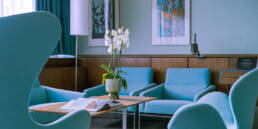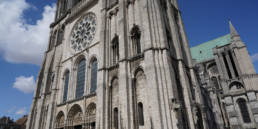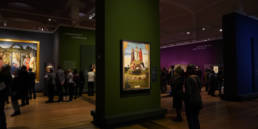Not far from the center of Munich lays the densely built campus of BMW, where the large factory and head offices of the car manufacturer also feature a museum and brand experience space that are open to the public. By now one of the best known things to do in Munich, I wanted to take a deeper look at how architecture, display, technology and people combine for an optimum brand storytelling. I can honestly say that had I not gone in loving BMW, I would have come out doing so. This is an experience not just for “car guys”, luxury lovers and engineers, but for anyone interested in architecture, design and history.

Architecture and history of the BMW Campus
There are actually three main areas you can visit at BMW Group: museum, welt, and classic. Each has its own fascinating architectural history and each tells a separate story that, together, completes the picture. The company was founded in 1916 (it merged out of two previous companies, in fact) and opened a plant next to Munich’s airfield, in what was at the time otherwise agricultural land outside the city. The museum was built at the same time as the new headquarters which opened in 1973: the famous four vertical cylinders and a bowl shape for the museum. For the museum’s existence we have to thank Architect Prof. Karl Schwantzer, whose proposal for the 1968 competition included it when the company’s brief did not!

The original museum has 1000 square meters of exhibition space with a central Guggenheim-like ramp; in a few decades this became too small, so a new section was built to display the permanent collection in 4000 square meters, while the older part houses temporary exhibitions (currently there’s one dedicated to the i-series and future mobility).
BMW Welt, on the other hand, opened in 2007 after an international competition involving 275 proposals. The winning project came from Himmelb(l)au cooperative in Austria, led by architect Wolf D. Prix, who was a student of Shwantzer. Legend has it that when Shwantzer got the call to tell him he’d won the contest to build the museum, Prix was in his classroom; later, when Prix got the call about building the welt, he was also teaching, and happily announced his one-upmanship of his professor.

The architects wanted the public spaces to echo and embrace the busy crossroads of their location, creating a series of wide ramps with silver barriers that literally create movement and that are a unifying element amongst projects of different eras. Both the museum and the welt have the very practical need of getting cars into exhibits and functional areas, so all the ramps are wide enough to do so – including the spiral of the bowl!

A third space just opened in 2016 – the BMW Group Classic commemorates the 100th year of the company’s operation with a conservative renovation of the warehouse that was their very first factory. Located about a kilometer away from the museum, the Classic responds to clients’ needs to properly restore their historic vehicles, as well as to the company’s need for space to preserve a vast archive. A working garage with glass walls allows you to see some spectacular private vehicles being serviced, while a stylish casual café is a good place for a coffee and sweet while perusing the small free display of archival material. Tours are available of the warehouse within, which holds about 100 cars, all of which are in perfect working condition.
BMW Museum
Some 600k visitors per year, of which 70% from outside Germany, come to the BMW Museum and spend 1-2 hours visiting its thematic exhibits. Here, you’ll learn about the whole history of the brand’s different divisions under the headings of things like design, weight, power etc. Although not strictly chronological, one does start with the earliest products, which were airplane motors and motorcycles. Surprisingly, the iconic blue and white logo and lettering haven’t changed very much since the first world war.

An area I liked very much, about design, shows how they prototype the body of full sized cars in clay. I love that a historic, tactile and malleable material is still the best option (in the era of 3d printers) for making something this large and important. Apparently, the design teams live in fear of showing these models to the head designer, who has a habit of walking in and literally cutting off whole clay sections he doesn’t like.

Men who like engines will enjoy a wall that shows the evolution of motorcycles, a hall full of engines, a sound display of M engines (ok I loved that part too), the race cars that won Formula 1s, and the stories behind cars like those that won the Mille Miglia or that were driven by James Bond. Displays explain the technical reasons behind the winning designs – in particular, early on, BMW engineers bet on lightweight structures when others emphasized heavy weights.

Design aficionados (and I put myself in this category) will love many things about this museum. A room with two iconic cars of the 50s and 60s is one of the most engaging. I learned for the first time about Isetta, a tiny and adorable post-war vehicle that was licensed from an Italian manufacturer. As cute as a Fiat 500 but even quirkier, this bubble car has a front door and escape hatch soft roof. If the door looks like that of a classic fridge, it’s because apparently it was made by a fridge manufacturer (though this may just be a legend). Its rear is narrower than its front, with 2 wheels closer together so that you almost can’t tell which way is forward. In post-war Europe and with minimal budget to develop new products, this was a line that built up the company’s economy, allowing them to then move into the sedans and sports cars they’re best known for. The Isetta, however, has remained a style icon and an important part of many peoples’ family memories, so in 2005, when this display was created, curators held an open call for family photos with the car, which are included in the museum.

Another personal favourite is the BMW Art Cars: 19 one of a kind vehicles that have been decorated by some of the most important modern and contemporary artists in the world. On display during my visit was one by Roy Lichtenstein; the Andy Warhol may be the most valuable Warhol in the world since it really is one of a kind. More recent commissions play with the shape and concept of “car”: you couldn’t drive the one by Olaf Eliasson as it’s wrapped in a kind of cocoon, while the 2017 car by Chinese artist Cao Fei includes digital enhancements in its display. [The company also provides grants, called the BMW Art Journey, to emerging artists coming out of Art Basel Hong Kong’s young artist category.]

A note on technology in the museum: I’m not surprised to find that the company has integrated the latest technological best practices that combine different ways of communicating information and engaging the senses. A well done museum app contains information about every exhibit, either written or with an audio file. There are points where standing activates overhead audio. When the BMW Welt opened, they actually tried to work smell into the exhibits, though this proved overwhelming in a large open space, so was quickly removed!
BMW Welt

It’s free to enter BMW World, and three million people a year take advantage of this! The concept here is to get friends and fans of the brand involved in a non-commercial space where you can learn about the latest innovations and also have fun. At the very center of the building is the pick-up experience: if you order a new car with pickup here, you get a special introduction to its features and staff sets everything up to your liking. Your first lap is driven inside BMW Welt before you spiral out down the ramp and into traffic.

Every new model of BMW, Mini and Rolls Royce is on display throughout the ground floor, and two dozen top product experts are on hand to explain everything in English and German. You can sit in all the cars and hang out for as long as you want; children are also given free reign to explore the exhibits, many of which include some interactive sections that they and their parents will enjoy. Max Bauer, who heads up brand experience here, tells me he often spends hours playing here with his three young kids, and he himself seems to get a child-like joy out of the interactive exhibits and high tech, futuristic product displays that he personally leads.

Aside from getting to sit in the ample back seat of one of 4000 luxurious Rolls Royces hand built each year (prices start at half a million and go up with customization), one of the highlights for me was the area dedicated to sensors and autonomous driving – hot topics about which the public has a lot of questions. We recently purchased a new car that includes sensors and a head-up display, which Max explained is about halfway up the ladder towards autonomous driving. But will BMW be putting autonomous cars on the road? Not even for road tests, and not likely any time soon (or maybe ever), since they tend to be slow and cautious. Rather, they’re improving the driving experience through connected technology, all the while thinking about the increasing move towards the car as leisure space.

Baby bimmer lovers can enjoy games in a dedicated area, or have their parents sign them up for a three-hour workshop in which they learn about sustainability and work in a team to build a little car of their own. The company doesn’t earn anything from the 5 euro workshop fee, and the space is carefully unbranded – though kids themselves seem very aware of the brand, and sometimes draw a BMW logo on the cars they make.
Classic Archive

Although smaller than the other two public areas, the Classic archive completes the picture and is the newest addition (opened 2016) to the brand experience. In the original factory room, which features a large window over the space where the floor manager could watch workers and control quality, about 8-10% of the vehicle collection is parked in chronological order in a display that you’d associate with a more traditional car museum. These cars may be getting ready to rotate into display in the museum area or are out for driving or other reasons, so the exact models that you might see out may change. There are cars and bikes used in films or that belonged to famous people, like a 507 that Elvis Presley drove while in military service in Germany; he had the white car painted red to mask the lipsticked phone numbers that all the ladies wrote on it. Here, you can sign up for a tour, or just poke around the public area wishing you could own one of the classic cars that clients bring in for service.

This area also hosts the company archive, and there’s a (free) room that shows some memorabilia, printed material and drawings related to the building and the early stages of the brand. Whenever anyone has to clean out an office these days, they’re told to call the archivist, who will evaluate what has to be kept and what can be thrown out. The collection is ever growing, but at this moment includes 1,200 series produced cars, 300 series produced motorcycles, 200 concept vehicles, 200 racing vehicles, 150 engines, 3,500 artefacts, 200,000 images, 15,000 hours of video, countless miles worth of printed material and some 40 terabytes of data!
Eating at the BMW Campus

As you can easily spent the whole day exploring these three areas, you’ll be pleased to hear that there are lots of good options for snacks and meals. At the Welt, there’s a whole range of dining. We had lunch at the Biker Café, which had very reasonably priced salads and sandwiches (5-7 euros) and desserts (3 euro), as well as coffee and drinks. The casual café at the Classic is quiet and design-oriented option with similar food and prices.

An upscale lunch restaurant is available for a leisurely gourmet experience, while for seriously high dining in the evenings, the 2-michelin-star restaurant Ess Zimmer led by Chef Bobby Bräuer offers tasting menus (from 146 euros pp, booking 6 weeks+ in advance).
Visitor Information
The BMW Campus is about 1 hour on public transportation from Munich airport (doable on a stopover) or 20 minutes from downtown. Day travel cards for the efficient transport system are available.
Tickets to the Museum cost €10, with reduced fees for various categories.
Find all information on the official website.
*With kind thanks to Max Bauer and Benjamin Voss, without whom this article would not have been possible. And to Tommaso for carrying my purse :)
PS: Other things to do in Munich

This Museum experience was my main goal on my visit to Munich, so I won’t be writing an article about the city just yet, but if you’re planning a day or two in the area, some other things I recommend are:
- The University area is very pleasant for a walk in nice weather, in particular to the large English Garden, a huge green space similar to those found in most major European cities.
- The Lenbachhaus Museum dedicated to the avant-garde 20th century artists (Klee, Kandinsky and more)
- The state Alte Pinakothek, which houses collections of German and Netherlandish Renaissance and Early Modern art – it has been under major renovation (which is why I didn’t visit) with sections reopening starting May 2018.
- For an authentic beer garden experience, other than the famous Hoffgarden, the second largest is near the Chinese temple in the English Garden.
- For something more international (and while waiting for this trend to hit Florence), I absolutely loved Aloha Poke, an adaptation of Hawaiian poke (more vegetables) by friendly German guys whose motto is “be kind when you can”. Their prices (9-12 euros) are also very kind.
Sign up to receive future blog posts by email
Alexandra Korey
Alexandra Korey aka @arttrav on social media, is a Florence-based writer and digital consultant. Her blog, ArtTrav has been online since 2004.
Related Posts
September 18, 2019
Re-Discovering Chartres: the Gothic Cathedral and Beyond
March 31, 2019
Mantegna and Bellini – Berlin exhibition review
May 1, 2018




